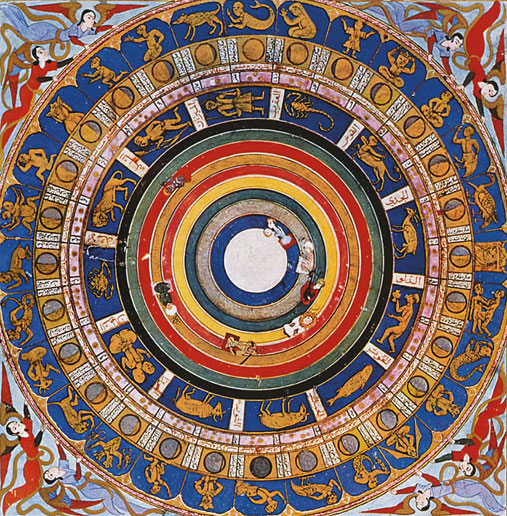“Without any doubt, as the terrestrial year exists, so does the great sidereal year. A terrestrial year is the turn of the Earth around the Sun; a sidereal year is the turn or journey of our solar system around the zodiacal belt.”
–Samael Aun Weor, The Age of Aquarius
The art and science of astrology has existed for thousands of years in all cultures. Astrology was once indistinguishable from astronomy, and tracking the celestial cycles was a natural part of life and religion.
There are really three different zodiacs to consider to understand astrology: the constellational zodiac, the sidereal (star) zodiac, and the tropical (Earth/terrestrial, seasonal) zodiac.
The sidereal and tropical zodiacs are how the constellations in the sky are translated and used as a functional astrological tool.
Constellational Zodiac
The constellations are clusters of stars that were given different names and attributes in ancient times and are often associated with mythological figures, gods, and deities.
The constellational zodiac is the wheel of stars that lines up with the ecliptic, the pathway that the Sun and all the planets appears to pass through from the perspective on Earth. These constellations were given the names and symbols that we currently associate with the zodiac: Cancer the crab, Libra the scales etc.

Sidereal Zodiac: The Stars
The sidereal zodiac is based on the constellational zodiac. As early back as the Mesopotamian era the wheel was divided into twelve parts of 30 degrees each. The sidereal zodiac is not a totally accurate depiction of the sky because each of the twelve zodiacal constellations are different sizes and take up more or less than exactly 30 degrees.
The sidereal zodiac is an idealized, or standardized, zodiac that is inspired by the constellations in the sky.
In accordance with the Hermetic principle “as above, so below”, the zodiacal signs seen in the stars correspond with and symbolize the activities of humanity on Earth. These correspondences were traditionally used for divination and ritual. Eventually astrology was used horoscopically to make predictions about an individual’s life.

Tropical Zodiac: The Seasons
The tropical zodiac is based on the rotational dynamic of the Sun and Earth, the interplay of light which creates the seasons. The year is naturally quadrisected by the two solstices and the two equinoxes. Each quadrant of the year is then trisected to create twelve sections of 30 degrees each, about one month.
Each 30 degree section of the year was assigned a name and signification based on the constellations of the sidereal zodiac. So the first moment of the spring equinox is called the first degree of Aries, and the rest of the signs follow in sequential order.
Around the time of the development of the earliest astrology as we know it (about 2000 years ago), the tropical zodiac was actually aligned with the sidereal zodiac. On the spring equinox the constellation of Aries was rising on the Eastern horizon, as well as being associated independently with the spring equinox itself.
While the sidereal zodiac is based on the constellations made uniform, the tropical zodiac uses that model and applies it to the seasons on Earth.
Both the tropical and sidereal zodiacal processes unfold in relation to our perspective on Earth. Although originally tied to the stars, neither is a literal interpretation of where the stars are in the sky.
Western and Eastern Astrology
There are many branches and traditions of astrology. Most broadly known in English-speaking cultures are Western astrology and Indian Vedic astrology. There are other types of astrology, including Chinese, Mayan etc. which are not covered in this article.
Western astrology has its roots in the Mesopotamian and Egyptian-influenced Roman and Greek era known as the Hellenistic period, from about the 1st through the 3rd centuries BC. This type of astrology uses the tropical zodiac, and is closely intertwined with other branches of Western esotericism including kabbalah, tarot, and alchemy. Samael Aun Weor’s writings on astrology are based on the Western astrological tradition.
Vedic astrology, widely practiced and revered in India for thousands of years, uses the sidereal zodiac.
Precession
Due to a phenomenon called precession, over time there is a slippage of alignment between the two zodiacs. About once every 72 years the constellations of the sidereal zodiac move one degree back in the tropical zodiac.
Because of precession, the zodiac sign that rises on the Eastern horizon on the spring equinox changes about once every 2200 years. When the sign changes that is called a new astrological age, signifying a sea change in human culture, religion, and civilization.
Ayanamsha
The offset rhythm between the tropical and sidereal zodiacs is known by its Vedic term ayanamsha. Currently, the tropical and sidereal zodiacs are about 24 degrees apart. Ancient and modern astrologers, East and West, have always understood precession and taken it into account.
The fact that the tropical zodiac does not line up with the constellations in the sky is used to try and disprove astrology as unscientific and superstitious. However, astrologers have always known about precession and the decision to use the tropical zodiac is intentional. Astrology is a multidimensional practice that functions outside of three-dimensional causality.

